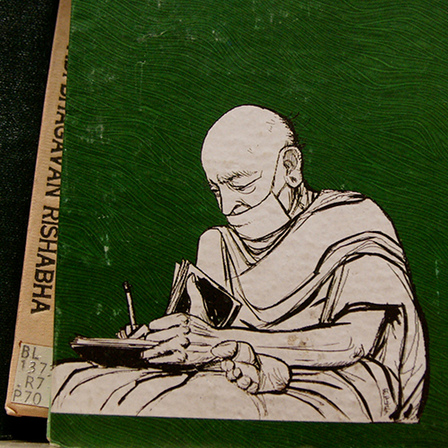For weeks I tried to reach the samanijis by phone and email to schedule a time to meet. I was finally able to meet them on the day of their departure. It took me so long to reach them, not because they didn't want to meet, but because they were busy with visits, calls, meetings, blessings. I met samani Sharda Pragya ji, one of a pair of samaniji who came to New Jersey just one month prior to our meeting, and was on her way to Orlando Florida, and Mudit Pragya ji and Sangh Pragya ji who had spent ten months in New Jersey and were going back to India. Mudit Pragya and Sangh Pragya were returning to Rajasthan to reunite with their guru, with other Jain ascetics, monks and nuns, saman and samani, sadhvi and sadhu. They were returning to follow their guru on foot, walking for the next two months as far south as Madras, or as far north as Delhi, before getting on a plane again in February to return to New Jersey, where cars take them from house to house, where community, time, space and place are different, changing, yet still a part of their Jain duties and way of life.
For the past three years, two Jain nuns from the Jain Vishwa Bharti Institute, a university and monastery in Ladnun, Rajasthan have been traveling to and residing in Iselin, New Jersey to teach and live as spiritual advisors within a diasporic Jain community. The nuns have a particular relationship to mobility, and to their places in the New Jersey, Jain, Indian and ascetic communities. Jain nuns and monks, or ascetics, are not supposed to travel by any mode of transportation other than their feet. Technology is traditionally renounced, and not a part of their ascetic lives. But a more recent sect within Jainism, the Samana Order, allows a type of nun and monk to travel, teach and live less strictly, in response to a changing world. The integration of technology, and technological modes of transportation affects the lives of the nuns and also the diasporic Jain community. The two nuns, Mudit Pragya and Sangh Pragya, who were living in Iselin for ten months, were returning to India to participate in a walking pilgrimage with their guru and an ascetic community in Rajasthan, which also affects their relationship to and with their bodies, in relation to mobility, modes of transportation and technology. The Samana Order, which promotes the movement of the nuns, has and inevitably continues to change Jainism, and the Jain community in India and globally. Many different, mobile and changing versions of Jainism emerge as people form relationships with the traveling nuns, and their circulating ideas, offering and producing, about and within, different understandings and practices of Jainism.
Jain Vishwa Bharati Center
Approaching the Jain Vishwa Bharati Center (JVB), I am surprised by how unassuming it is, a suburban street, and a small house flanked by homes decorated with Christmas lights. Facades hide private lives, secrets, intimacies, joys, religious sites. There is nothing that distinguishes the brown clapboard house from the others on the street, except a small, computer printed sign on the door: Jain Vishwa Bharati Center. Entering the house, I remove my shoes, and greet the samaniji. The space has no furniture, besides a few small tables, placed on the carpeted floors to support books, a donation jar, and a few pamphlets. On one side of the room there are pictures of Lord Mahavira, and the samani's guru Acharya Tulsi and guru Acharya ?Mahapragya. Additionally, there are two poster boardsmade by school children, outlining some of the things they learned about Jainism, most likely from Sangh Pragya and Mudit Pragya. In the absence of non-transatlantic-traveling ascetics, Jain centers have served as a spiritual base, a surrogate to the philosophy as taught by ascetics in India. There are only three Jain Vishwa Bharati centers in this country — the other two are in Houston and Orlando — which host and house the samani ascetics for center activities and spiritual guidance.
According to the website, the JVB aims to "build a sense of community and belonging particularly among children… organize and celebrate Jain festivals and events, to create an environment that fosters unity and social harmony for all mankind" (JVB website). Samani Mudit Pragya and Sangha Pragya have been in New Jersey for ten months. While Mudit Pragyahas been a samani resident of the Orlando center, this is the longest she has spent away from India, away from her guru and the ascetic community.
Globalization, Mobility and Diaspora
People travel, ideas circulate. This is not a new concept; migration and mass movement of people predate the ancient Jain religion. Yet, transnational and global flows have been reclassified, understood as a particular phenomenon under the particular conditions of late capitalism and globalization, with new combinations of, and affects between, the technological, economic and political.[1]
Jains live and work in places other than where they are born, creating different social orders, negotiating and producing new cultural meanings. The Indian diaspora is huge, in the US alone, there are estimated to be over 2 million Indian Americans.[2] New Jersey has the most Indians in this country, and in Iselin, you feel like you are in an India. Oak Tree Road, the main street in Iselin, has always beena place I've visited with family. I've gone countless times with my stepmother to buy Indian groceries. She knows where to get the cheapest eyebrow waxing, gold bangles, Bombay chaats (snacks).[3]
The day that I went to visit the samaniji, I traveled alone, and really felt like a foreigner. I picked my own place to sit and drink chai, eat samosas, buy groceries, look at the latest Hindi film soundtracks. I walked to the Jain Vishwa Bharati Center, where the samani stay, as a student, not as the cousin of Shweta ben or the daughter of Dilip bai. But I am a different kind of student than the samaniji are used to meeting. I want to know about them, their lives, their experiences, but first I must learn about their religion, and as Mudit Pragya tells me, there is no separation between the two.
Jain Background
My father is always quick to tell me that there are no real rules in Jainism, just guidelines, and that each individual follows them as he or she can. In general, Jains do try to follow, according to their circumstances, five main precepts: non-violence, truth, not taking that which is not given, sexual restraint, and non-possession or non-attachment. Equality of all life and spiritual independence are two main ideas of the religion and philosophy. Intense emotions and passions like cravings or violence towards the material world are seen as cause for further attachment, so self-control is an important aspect of the practice. Most Jains try to avoid attachment, or negative karma, through different acts of prevention, evasion and care. A common image that comes to mind, for those who know about Jains, is the ascetic sweeping the ground before he/she walks to brush insects off the path, out of the path to moksa, or enlightenment and liberation.[4] While there are different beliefs as to how, and who can attain it, the main purpose of living is for Moksa, and Jains use religion to help transform their soul (atma) to gain liberation from this world.
There are two major sects of Jainism, Digambar and Svetambar. The differences between Digambar and Svetambar, which contain various sub-sects, come from different interpretations of the same books. Digambar monks don't wear clothes because they believe that clothes, like other possessions, increase dependency and desire for material things.[5] According to this thought, they don't believe that women can attain moksha[6]: "There is no moksa for women; because they are inferior to men… because of their possessions… because her biological state is incompatable…" (Yuktiprabodha #26, 30, 38 Jaini, 170).
Svetambar monks and nuns wear white seamless clothes and believe that women can attain moksa, "There is moksa for women; because there is no lack of the causes necessary for its attainment; as is the case of men. The causes of moksa are right view, right knowledge, and right conduct, and all of these in their perfect form are found in women" (Tarkarahasyadipikavrtti #44, Jaini 156)).
As mentioned, there are many sub-sects, and in 1974, a committee with representatives from the different sects created a new text called the Samana Suttam. The nuns that I met are from the Samana order, of the Svetambar Therapanthi, under the guidance of guru Acharya Mahapragyaji.[7]
Ascetics
Jains, ascetics in particular, should not cause harm or cause anyone else to cause harm to any living thing, directly or indirectly, if they are to attain moksa. Ascetics place a muhapatti (cloth) over their mouths at all times, so as not to accidentally inhale any living thing; they don't take showers or baths because moving water can be harmful to microscopic organisms. Transportation is done by barefoot, and very carefully. Yet, one of the most important requirements of the ascetic life is movement, as Mudit Pragya told me, "All the time you flow, flow free. We go, we walk, it's a very good experience and we learn a lot of things and we meet different kinds of people and they also learn a lot of things, how to live their life, they get peace, we also feel good. If we stay in one place for longer, for long time we also feel attached, attached to this, attached to that, attached to them. This attachment is no good for us. So, this is good for flowing. Like water, if water flows, then it remains pure, not dirty, if water remains in one place for long time then it gets dirty. So motion, this is good."
Ideally, ascetics, traveling in groups of at least two, won't spend more than a few days in one place, except during the rainy season, because walking during monsoon could endanger things that grow on the ground. Mudit Pragya elaborated, "In monsoon all nuns and monks stay on one place. Because in rainy season there is more scope to kill. Violence. Small insects. So they want to avoid violence and they live their life nonviolently and they can follow their non-violence vows."
According to Lawrence Babb, this practice "reinforces ties between laity and ascetics… Resident ascetics give daily sermons and exercise more than ordinary influence on the community, the rainy season retreat is a season of enhanced piety among lay Jains" (Babb, 56).
The practices of Jain doctrine are derived largely from monks and nuns — followers are dependent on ascetics, or mendicants, who are considered the "sole true experts" on Jain issues (Cort, 110). "The lay person obtains well being by establishing a personal relationship with the mendicant, a relationship that is actualized through gifting, praise, worship, and devotion" (Cort, 117). Being in close contact with ascetics inspires more spiritual practice among Jains, in this way we can see how ritual action and repetition of practice produces more devoted subjects[8].
The same kind of repetition or practice is important for the ascetics as well. Sangh Pragya elaborated a bit on practice, "This is our practice, and this is our renunciation, feeling of renunciation. Already we have inside this feeling of renunciation, and then we practice it, and we practice everyday, meditation, contemplation and positive thinking, also the relativity of this world. That's why we get more and more spiritual."
Jains are dependent on ascetics for spiritual guidance, but the nuns and monks are also dependent on non-ascetic followers for their physical needs, like food, water and shelter. Interactions and regular transactions between ascetics and laity are a major part of the religion, which seems like a paradox, since the ascetic (and the non-ascetic Jain) strives for non-attachment.[9] Yet, P.S. Jaini explains that Jainism has remained a strict discipline through the connection between ascetics and non-ascetic Jain, "Ascetics and laity are united in doctrine, ensuring communal stability and survival" (Jaini, 58).
Marcus Banks discusses this strictness, and the maintenance of guidance as the reason why Jainism survived in India while Buddhism did not. This argument is interesting in the context of the Jain diaspora, because if a connection between ascetics and Jain followers is crucial for the sustenance of the religion, then changes would need to be made to ensure that the ascetics and Jain followers stay in close proximity. Changes would need to be made so that ascetics could serve the larger, mobile, resettled population.
The precept stating that Jain ascetics may only travel by foot had kept ascetics from traveling outside of India, which is one of the reasons why Jainism is little known outside of India. In the 1970's, when Jains started traveling to and settling en masse in places like London and New Jersey, new ideas within Jainism started to appear, and settle into the religion.[10]
New Movements
Neo-orthodoxy, as described by Marcus Banks, adapts Jainism to modern times, choosing from Jain writings and teachings that which seems best suited for the present. While new ideas may seem to disrupt the religion, it is Jainism, and the multiplicity that it supports, that allows for divergent people with divergent beliefs to be Jains. In Mimesis and Alterity, Michael Taussig describes the act of becoming different while remaining the same, elaborating on the ways that it is possible to stay the same through, and because of, adaptation.[11] This way of thinking is helpful in terms of understanding how the transformation of, or the development of new beliefs within Jainism can be not only legitimate, but can reinforce Jainism. Changes and different forms or adaptations of Jainism do not undermine the ancient religion. As Taussig describes, "one thing becomes another thing while in some profound sense remaining the (mimetic) same…" (Taussig, 116). This is especially true, because an 'original' form of Jainism can't be found, given the expansive history and the different interpretations of Jainism, not to mention the numerous understandings between the various sects.
Digamburs and Svetamburs have different ideas about the paths, rituals and rules of Jainism, but they still see one another as Jain. The adjustments and transformations that we see now in Jainism can be understood as a part of the trajectory of the history of the religion, which has undergone numerous changes through interpretations by different saints and ascetics who generally maintain a belief in a united Jainism, or a Jainism that can contain multiple interpretations. Similar to what Taussig describes, it is possible for Jainism to be Jain through change, "through the very act of transforming, conserving the notion of an underlying sameness…" Taussig's understanding of the mimetic faculty of thought, belief and doctrine, as imitative, duplicative and then simultaneously creative and generative explores the interrelationality of "copy and contact." In Ladnun, Iselin, Houston, Orlando, London, there is a common identity and identification that is perceived by the actors, while the principles are extended to meet (external) and make (internal) change.
Samana Order
Within the orthodoxy, ascetics can't travel outside of India. The Samana order, developed in 1974 by a group of Jain ascetics, is a response to the strict rules regarding travel, and another way for ascetic teachings to reach out, especially to Jains who are living abroad. It is a way for the diasporic communities to receive guidance, and a way to sustain a religion that depends on an ascetic-follower connection.
Mudit Pragya explained the significance of the Samana order, of which she is a part,"the Samana order is relevant, we need it for our world… this is a modern nuns order, and that (sadhu/sadhvi) is ancient, so the combination of both we need. Because that tradition also we need to run, we don't want to stop that one. And also this is the demand of this present day, modern era…"
The new Jain order was established by Acharya Tulsi and is continued now by the samani's guru Acharya?Mahapragya. Saman and samani follow the lifestyle and precepts of the Jain sadhu and sadhvi with a few exceptions: they can use means of transportations other than their feet, they can stay in one place for an unspecified duration of time and they are allowed to take food which is prepared for them.[12] Established to reach international Jains, samani have since taken other roles because of the more lenient restrictions, thus creating new positions for ascetics, as described by Sangh Pragya, "There are many things which can not be done by sadhvis, which can be run by samaniji, like the University, samaniji can join the University. (For)sadhu/sadhvi this is not possible, because they cannot stay in one place for long time, so their rules are different from our rules… They cannot travel and we can travel, and so we can come here also, stay here also, we can communicate with more people, impart the training about non-violence, compassion etc. here also. They cannot come here…"
Samani give lectures and conduct meditation camps wherever they are, continuing what Chitrabhanu started by representing Jainism at global religious conferences.[13]
At the 2004 Barcelona Parliament of World's Religion: "They became the center of attraction and curiosity, as many people at the conference had probably never seen a Jain monk or a nun before."[14] Meeting with the samaniji felt different from my experience with ascetics in India, which could be because of the differences between the individual ascetics, the different orders, the difference between being in India and being in New Jersey (for them and for me), my different position. Most likely, all of these factors, and others I haven't thought of, combine to produce something different, which is still very Jain.
Mudit Pragya asked me if I could arrange a talk or a Preksha meditation workshop at my school, and while I am thankful that this request disrupted my notion of our roles, and what we could expect from each other, the line between proselytizing and teaching is blurry, particularly blurred when a part of the mission is clearly stated as "spread(ing) the universal message of Jain philosophy and Jain wisdom to the world" (JVB website).[15] Still, while promotion of Jainism is a part of the Samana Order, it was created primarily "for the spiritual care of Jain people living abroad" (JVB website).
During our conversation, Mudit Pragya felt very strongly about the need for ascetic representation outside of India, "people need more religious guidance here. In India people get sadhvi, samanaji. Here, people don't have here. People are unhappy, need more inner peace. If we come here, give service, it is selflessness, impartial, we give peace, new inspiration. Here they need more guidance. We devote our lives to mankind to guide, train people to live life peacefully. We feel happy to be here. We feel it is more important to be here. Nothing can give peace except spirituality. We show path, and where to go…"
Sangh Pragya elaborates on the ways that their knowledge builds connection, "the people who live here, they cannot get the real scriptural knowledge and religious knowledge. How they can get? So, if we come here, then they can sit with us, they can query to us. We can answer them, impart our knowledge among them, so we also feel happy also. Both the things are side by side… our main aim is to spread the humanity wherever we can…" Mudit Pragya continued, talking about the benefits of and for the samani to travel to different places "Sometimes we also feel we learn a lot of things from there, where we live, where we stay, so here also we learn a lot of things, because here's more of opportunity, and more comfort to learn to get knowledge to acquire experience, so this is good." She elaborates on the reciprocity that Marcus Banks talks about regarding the connection between ascetics and non-ascetic Jains. It is interesting to hear Mudit Pragya talk about place-based enjoyment, or the benefit of being in one place or another, considering the apparent ambivalence or disregard for location.
Space/Place/Time
With the Samana Order, different concepts of space, place and time are being enacted[16]. As argued by Doreen Massey in Place, Space and Gender, place is interactions and actions, and for the samani, place is also interactions and actions, as guided by a guru. The samani go wherever they are told to go, and seemingly with no preference, as Mudit Pragya explained, "I go wherever my gurudev tells me to go. For me, mentally, it is all the same. We are living here, surrounding material things, but inwardly we don't feel different."
As a samani, Mudit Pragyahas traveled to the US, Hong Kong, Thailand, Indonesia, Canada, UK, Switzerland, Germany, Belgium, Holland, Italy, Israel, Romania, France, Taiwan, Singapore, Nepal and China, conducting Preksha meditation camps and seminars, attending conferences and conventions regarding Jainism.
For samani, as for most people who use different modes of transportation, there are multiple meanings and experiences of distance and time, but for the samani, this is especially marked by place. Place, which happens to be India, where the guru leads them on walks, where they only walk, and place as away from their guru, where they use planes, trains and cars.[17] As Mudit Pragya told me, "In India we go everywhere by walking, wherever we go, we go by foot, it takes time. Some place that takes five minutes by car takes a half hour for us. Time is different. In India we go by foot, time is spent differently." She continued to describe how samani in India rarely use technology that facilitates temporal efficiency or speed, "The convenience of using things, the working process is different, it's easy to spread the message to others, electronic media is fast here. Living at the center you can spread the message easier. Even though all this is used in India too, in India samaniji don't use email and phone because there are so many followers living close, we don't need email or phone, we don't involve ourselves, our time goes into different activities."
Time, place and space interact in different ways, and are differently experienced, while the position and devotion of the samani supposedly remains the same, regardless of place, space and their relationship to time. Yet, place does have a meaning, in terms of social relations. The energy from the guidance and support that the samani get from their interaction with their guru is different from the energy they get from the Jains in New Jersey, and this is different from the energy the Jains in New Jersey get from the ascetics who travel to guide them.[18] Mudit Pragya told me about the reason for returning to India, "… this is our discipline, we also need more guidance, we also need energy, recharge our battery to work more and more in good way. That's why we go back to India."
We can see clearly how localities like Iselin, New Jersey, Orlando, Florida, Houston, Texas, Ladnun, Rajasthan, or any place the samani travel to, are "about the intersection of social activities and social relations and, crucially, activities and relations which are necessarily, by definition, dynamic and changing" (Massey, 136). For samani, who have no choice as to where they travel, and conceivably no attachment to localities, to places or people in places, geography and social relations are temporal, and always unpreferentially changing. Yet, there are contradictions, as there are multiple interpretations of place and space, as understood by the multiple subjects involved in this kind of exchange. While non-attachment is a goal, and a part of the samani practice, during my interview, the two younger samaniji I met alluded to missing their non-traveling guru and ascetics.
Sangh Pragyatold me,
"Actually it's not possible to put words to an experience, but I can say that when we left the first time our country, because we were brought up there, we got everything from there and when we come that far, here… so it's very difficult actually, but we are dedicated to our guru, if our guru has decided to send us here and we see also what is the aim behind it. If we can do anything for our order, if we can do anything for our guru then we are ready. We can face any difficulty, we can turn our guru's decisions and our desires."
She qualifies her longing by stating her dedication, but I wonder in what other ways the distance could be difficult, beyond feelings of attachment.[19] Sangh Pragya continued, "it is difficult, in fact if I can say, that it is very difficult to stay here far from our guru, from our other samanijis, our nuns and our monks, everything, our society also. Because here, there is also a community and many American people are there also, but everything is different, the atmosphere is different. You can experience that. So, it's difficult and also we came here because of our dedication towards our guru…"
Again, the commitment to the Samana Order seems to neutralize her desire, but there is certainly a longing for place, as place is marked by her social relationships: the guru and the other ascetics. Besides social interactions, place is also the relationship to things, such as technologies, which enact something different on social relations. Mudit Pragya spoke about phones, and cars making communication easier in the States, but do the technologies make communication easier because of the technologies themselves, or because of the distance between people in New Jersey, or because walking or talking is different in Iselin? I walk all over New York, distances that people who take cars are often surprised by, but when I walked from the Jain Visha Bharati Center to the train station, I felt like I was on a major expedition. My ten-minute walk along the side of the highway, trucks speeding past me, felt like an hour, my discomfort and fear of the fast cars created a larger memory to fill a longer time period than would be expected from the ‘actual' distance between the house and the station.
As mobile subjects, the samanis enact mobile concepts of space and place, in terms of dynamic social relations, creating alternate meanings in Jainism and in response to changing times. As we saw through Sangh Pragya's response to being in New Jersey, space is not singular, and is understood by different people, differently. Place too, must be understood as particular and unique, nodes of and within networks of social relations, experiences, interpretations, and moments, in relation toothers. It seems obvious to say that Sangh Pragya and Mudit Pragya would have different conceptions of Iselin, New Jersey and the JVB Center, though they both arrived and are departing at the same time, and spent every day with each other. What is interesting to me though, are the differences in light of their shared devotion, belief systems and practices of Jainism. This further attests to the multiplicity of possibilities within Jainism, and to the multiple understandings and experiences of place.
We can see that place is multiply experienced, and socially differentiated, in terms of who moves and who doesn't, and the power involved in such decisions. The identity of the nuns, as samani, is made clear by their departure from India.[20]
In India, especially during pilgrimages, or walks, there is no way to see any difference between the sadhvi and samani, they both wear white cloth, they both follow their guru, but outside of India, it becomes clear that the ascetic is a samani, because she has obviously traveled by other means than her feet.
Samanis travel because their guru tells them to, and while they don't question the motives or the reasons why they were chosen as samani and not sadhvi, Mudit Pragya shared some ideas with me about this, "In 25 years, so many samanijis are initiated in this rank, but after that, our guru also turns some into sadvhi, so this is also the flow, samani to sadvhi, and sometimes they give initiation directly to sadhvi… There are some reasons, it depends on guru, and guru decides if there are some special qualities, if he thinks that this girl is proper, able to go out and spread the message and she can communicate. And capacity of experience, capacity of knowledge is one part. And number two is sometimes he thinks in our order, in our sect, what kinds of needs. In sadhvi, sometimes they need more sadhvis, sometimes they need more samaniji. They make balance."
Samani occupy different positions, and different physical and social spaces, their mobility completely dependent on the ways that the guru understands the individual, or the way that he understands the ascetic order. Supposedly, the relationship between sadhvi and samani is not hierarchical, as discussed, sometimes samani are chosen for particular qualities and sometimes an individual is chosen for the collective needs of the order.
Sangh Pragya told me that the nuns are happy with each position, "It's decided by our guru, we are dedicated, we can also be sadhvi, we want to be sadhvi, but if our guru wants us as a samani, and if we return and he gives our initiation as sadhvi then we are ready for that." There are, however, elements of power and control both from within the Samana Order and outside, which could create diverse social effects, reflecting, and reinforcing order. Mudit Pragya talked about the guru's position of power," Also all samaniji, monks and nuns they come to guru, and if we have emergency we can ask, and we can stay somewhere." The guru, it seems, makes all decisions about movement.
Once a year, guru Acharya Mahapragya gathers the sadhvi, sadhu, saman, samani, and other Jain followers for an event and a special kind of pilgrimage. The newly arrived Sharda Pragya and the other samaniji she traveled with were going to miss the event that Mudit Pragya and Sangh Pragya were returning to India for, as described by Mudit Pragya, "So in our sect we have one function once a year, a big function, and on that occasion all monks and nuns and samaniji we gather over there with our guru, at that function he guides us for the future, this function comes in January or sometimes in February." The reason for their granted absence from this function, was due to another, external kind of power, which was to affect the position of the two samani. The US embassy granted a year-long visa to Mudit Pragya and Sangh Pragya, but only a two and a half month visa to the other samani, and this was given in November, as Sharda Pragya explained "we were granted only two and a half month visa, and it was expiring, so that's why he sent us, because of the embassy, and opportunity…" Sometimes power comes from unanticipated places, but it too enacts change and different relationships to place, space and time, for individuals and for groups.
The samani's purpose, as mobile agents, is to inhabit social spaces, articulating social relations. They take spatial form in and through their interactions with one another, and with the other Jain followers. One way that Doreen Massey thinks about space is as particular moments in intersecting social relations, nets which are "constructed, interacted with one another, decayed and renewed. Some of these relations will be, as it were, contained within the place; others will stretch beyond it, tying any particular locality into wider relations and processes in which other places are implicated too" (Massey, 120). The interactions between Jain followers and the ascetics produce thought, spiritual connection, information that is marked by, but lasts beyond the interaction. The JVB Center, evacuated by its samani for the moment, is still marked as a Jain site, the blessings the samaniji gave before their departure are still with the Jain follower, even though the samani are in India. The global is in the local. In the process of the formation of the local, the nuns bring their expertise, their 'authority' from India, but it is conceivable that this authenticity can be born here as well.
As Mudit Pragya told me, "Anyone can be a samana or samaniji in here or India, Jain or non-Jain, anybody he or she wants to be samana/samaniji can be, he can live religious and spiritual life." The new relationships produce multiple possibilities and identities. "The geography of social relations forces us to recognize our interconnectedness, and underscores the fact that both personal identity and the identity of those envelopes of space-time in which and between which we live and move (and have our 'Being') are constructed precisely through that interconnectedness" (Massey, 122).
Through varying interactions, movements, linkages, contradictions, collaborations, we get a global, and perhaps a universal sense of space, geographies of similarity and geographies of difference, fully linked and integrated through ideas, within Jainism. The networks of thought are not place-bound, and are constantly changing and extending, to unforeseen local and global places.
Global Flows, travel and(dis)placement
The interface of global and local is not oppositional, but relational. The two scales create and constitute one other, interact and influence each other, making new and increasingly complicated and interconnected combinations of places as situations. For the samani there is little space allowed for the markings of travel, but the movement certainly enacts effects, both for the ascetic subject, as described by Sangh Pragya's yearning for her ascetic community in India, and Mudit Pragya's discussion about technology making communication easier in New Jersey.
The samani's travel surely affects those who share a space with her as well — the Jain community in Iselin is affected by the presence of the samaniji who leads daily meditation, and weekly yoga, gives teachings and blessings. The non-Jains in Iselin are also affected by the presence of the ascetics; the JVB neighbors who decorate their houses with Christmas lights must be aware of the surplus of visitors next door, and their children might have been in a class where the nuns came to give a presentation.
In their article 'Beyond "Culture": Space, Identity, and the politics of Difference,' Akhil Gupta and James Ferguson consider global changes through "the invention of new forms of cultural difference and new forms of imagining community. Something like a transnational public sphere has certainly rendered any strictly bounded sense of community or locality obsolete" (Gupta and Ferguson, 9).
While India travels with the samaniji the religion in some ways circumvents nationalism. It is Jainism that the samaniji is bringing to New Jersey, and it is the religion that forms connections across national lines.
Appadurai discusses derritorialization in Modernity at Large, as a post-national social order, a condition for cultural interconnectedness, and the negotiation and production of new cultural meanings (Appadurai, 36). The new places that the samani visit are possible through new technologies that change the relationship between time, space and place, allowing the formation of new networks, communities, identities, understandings and relationships to and with Jainism. The fact that the ascetics are all from India problemetizes a non-national understanding of Jainism, but the link between religion and place is not necessary, if we understand place through social relations. As Jain ascetics, and non-ascetic Jains move, and as Jain ascetics move to be near non-ascetics, there are more possibilities for different social relations forming strong, and different Jain bases outside of India.
Home and away are temporally shifting categories that mean different things to different people, as affected by personal, cultural, historical, religious and political experience. Relaxed US political policies regarding immigration and visitation happened around the same time as the creation of the more lenient Samana Order, which allowed ascetics to travel to the US. But, as seen by visa restrictions, this is not a linear trajectory. Changes could be made at any time, changing the ways that the ascetics reach the world, and the ways that the transnational, global Jains can be reached by the ascetics. When I spoke to Mudit Pragya about the differences between Orlando, where she stayed for four months three years ago, and New Jersey, she told me "the unity of community in Florida is the same. There, there is some more of a religious community, the center is there for 10 years – – they know more, they get more knowledge, they learn a lot of things about spirit… Here, it's just 3 years, so due to time, there is a little difference. Here they need more guidance and knowledge." Mudit Pragya notes the changes in the religious community of Florida, due to the samani presence. In ten years, Jain religious knowledge and spirituality has grown. New Jersey is seven years behind.
Neither India nor the US, however, can be seen as having original or authentic versions of Jainism, because both produce their own authenticities, their own subjects, their own real versions of Jainism and Jain identity. While it is common for newly arrived Indians to view India as home, the longer individuals or families make homes outside of India, or the longer they stay in a different place, the more likely they are to think of home differently, or at least multiply.[21]
Through a Jain lens, there should be a way to understand home as neither India nor the US, but both, or neither, through non-attachment. Again, place is formed by social relations, and for the ascetics, home refers to a religious community. The Samanijis I spoke with did not necessarily miss India, but they did miss their religious community. There are possibilities for reconfigurations of home and away, non-binary feelings towards exile or home, placement or displacement, location or dislocation. With the movement of the nuns, and the formation of another kind of link to the Jain religion in New Jersey (and elsewhere), there are possibilities for destabilizing conventions of an authentic other, because the other can be here.
Still, feelings of connection and authenticity are, of course, contingent and based on multiple factors and interactions, in relation to history, used to unpack the notion of shared orcommon experience (Kaplen, 25).
The emergence of certain kinds of subjects, like Jain nuns and a Jain community in New Jersey are contingent upon, and formed in relation to, social and religious change. Home, as an authentic base, is not an intrinsic territory, rather, it is the construction of clusters of identity. It can also be seen as a particular construction, given Jain imaginaries or ideologies of non-attachment. The meaning of travel and expatriation can be seen through a Jain ascetic disregard, or ambivalence for place. As Mudit Pragya explains, "We don't have any individual choice, because we get everything, because we don't have any materialistic desires, we are spiritual, totally spiritual, we want to be more and more spiritual, and that can be got only free from desires. So these material things we don't feel to get all these things. Whenever we visit pilgrimage and any other places, it is just we visit for our knowledge and to get experience, not for fun and notentertainment."
Collaborations, creation of Jainism as multiple
So how can we reconcile the ambivalence towards place through practices of non-attachment, and then the articulations of preference? I've talked about how Jainism exists differently for different people, and how the Samana Order offers another Jainism, another practice, on the bodies of the nuns, on the minds of Jain followers and on the religion itself, in very interconnected ways.
Annemarie Mol unpacks parts of things which are not fragments showing that "to be is to be related." "The drawing together of adiversity of objects into a single name involves various modes of coordination"(Mol). My thing is Jainism, and Jainism is comprised of many holy books, many saints, and many people, coordinated in and as different practices. "If an object is real this is because it is a part of a practice. It is a reality enacted" (Mol). Jainism exists as a practice, practiced differently by different people.
Anna Tsing's concept of friction can be applied to the different enactments of Jainism, the different intersections and interferences between each person, version, act, action, enactment. In this way I am conflating the Jain religion with Jain followers and ascetics, seeing the two as inextricably linked, by extending the possibilities for many versions of the religion existing for the many different followers and practitioners. Tsing's ideas about fragments, "the ways in which stories engage with and create the materiality of the world," show how materiality moves through stories, accounts and exchanges, creating life and a complexity of relationships that go into the creation of identity. Multiple Jain identities are enacted through encounters between individuals and groups across national, transnational, and global difference, creating new configurations of and for individual and cultural identity, as a multiple Jain identity.
Difference can be seen as a site of connection, and different meanings or intentions, produce information, and action, different versions of Jainism, different Jain understandings, possibly as universal, "To turn to universals is to identify knowledge that moves-mobile and mobilizing — across localities and cultures" (Tsing, 7). The socially constructed spaces and places through collaborations produce "productive friction of global connections," "contingent lineages," and "shards of genealogies through which presents are formed" (Tsing 127).
The present state of Jainism is a particularly collaborative site, contingent and mobile, a time where we can locate possibilities for future alliances. Jainism is truly at an interesting place, considering the recent opening of the religion through the Samana Order, of mobile subjects who have 'expert' ascetic knowledge, thus resulting in, or enacting new connections and practices. Yet, each aspect of Jainism, as it exists for the non-ascetic Jain living in India, the ascetic living in India, the ascetic living abroad, or the non-ascetic living outside of India keeps its own scale.
It is possible that none, or only some of the different experiences with Jainism, will interact with each other, meet in physical or ideological planes, but there are possibilities for more interaction given the new possibilities created within some of the spheres. Marilyn Strathern approaches culture as practice and process — ideas, action, things are constantly being made and remade, as are meanings in relation to the constant process, through "radiating relations" (Stratherm,68).
Strathern explores the multiplicity and plurality through which connections are made, showing how relativism reveals everything as partial, and that recurrence of relations generates information, theory, knowledge and experience. A particular Digambur sadhu might not actively participate in this new mobile Jainism, but others who do, a samaniji in Houston, or an American in Delhi, affect the Digambur sadhu, and affect Jainism, through their knowledge of and experience with Jainism. Through performance and enactment of social relationships, there is space for identity development, and possibilities for change, "In making connections visible, people assert their ever-present capacity to act upon them" (Strathern 102). Strathern elaborates, showing how relationships constantly change and develop, creating "layering versions and complex outgrowths" of and in relation to each other. Seen in this way, Jainism is multiple, and whole in each version, and each version interacts with others, especially and more often through accelerated contact and connection with each other.
Through the movement of the samaniji, Jains and Jainism experience other versions of Jains and Jainism, which are fully Jain. Jains living internationally experience another Jainism beside, or along side texts, ritual, prayer, and the ascetics who they may encounter when they go to India. New inspiration and teachings can affect new kinds of relationships to the religion, and new versions of it as well, which fall within the parameters, while simultaneously extending and stretching beyond. It is interesting now to think about what gets taken and what gets left behind through translation and transportation of this multiply understood, experienced and practiced Jainism, and how each version affects new and different understandings. It is interesting also, to think about the reasons why changes are made, the needs that are fulfilled by change and the changes that are possible and inevitable for the future.
[1] In Modernity at Large, Arjun Appadurai describes how the transnational flows of people, goods and knowledge become imaginative resources for creating communities under the increasingly growing globally-defined possibilities (Appadurai 1996).
[2] The 2000 census reported 1.5 million Indians living in the US, but various internet sources range from 2-2.5 million
[3] My mother, who is not Indian, also goes to Oak Tree Road with my non-Indian stepfather to eat food, and buy groceries, but different kinds of groceries than the kind my stepmother buys. It is important for me to mention that Iselin is known outside of Indian communities as well.
[4] Moksa can be understood in different ways, but generally it is understood as the realization of the soul's true nature, and liberation from the cycle of death and rebirth, the suffering and limitation of worldly existence
[5] Again, according to Jainism, desire, or attachment to/for anything ultimately leads to unhappiness
[6] I have not found anywhere a reason why nuns must wear cloth, besides keeping men from feelings of desire. The debate about the sexuality of the female body is long and ongoing. Svetambars acknowledge that the reasons why nuns wear cloth are not personal, but societal.
[7] The Samana Order of the Svetambar Therapanthi sect, which I am concerned with in this paper are non-image/idol worshipers, and believe in religious and transcendental work, such as teaching others Jain doctrine, as the way towards spiritual advancement.
[8] Varzi discussed ritual repetition, and practice in relation to subject and identity formation in Warring Souls.
[9] I generally don't use the term laity or lay person, because this connotes a strong separation, or distinction between ascetics and non-ascetics, which I don't want to reify. I haven't found the right word, but generally I use Jain followers or non-ascetic Jains.
[10] In 1965 the US INS act loosened immigration restrictions, a major factor in the growth of Indian immigration
[11] Taussig talks about this through the Cuna, and I find that it matches other spiritual, ideological conceptions as well.
[12] Jain ascetics try to avoid causing harm and causing anyone else to commit harmful act, and since preparing food is considered violent, ascetics try not to take food prepared specifically for them.
[13] See footnote 8.
[14] This is taken from a website www.jaina.org. I add this quote only to show the perception of Jains as being largely unknown or overlooked, and the reason for this has generally, or popularly been seen as a result of the ban on transportation for ascetics.
[15] My feelings about proselytizing aside, I was always told that it was not a part of the Jain religion. It is more difficult for me to reconcile changes in philosophy, but again, it is important to see this change as a part of Jainism.
[16] I can't say taking place, and I find Annemarie Mol's position and understanding of enactment to be helpful.
[17] I don't know whether the samaniji use transportation in India in the same way as they do in the US. I will need to find out if they use trains or planes to reach a lecture, or teach meditation, or if they take a car to go to the airport.
[18] I use energy not in a mystical sense, but because Mudit Pragya uses it to talk about what she gets from being in India. Energy here can be seen as a type of interaction.
[19] I am not questioning Sangh Pragya'a dedication or spirituality, but I use this example as a way to show the different responses, possibilities that fall within a Jain conception of devotion. The fact that Sangh Pragya misses India does not not make her an ascetic.
[20] The movement of the samani can also be seen in terms of gender, and construction of gender relations, as it is the nuns and not monks who travel. The fact that it is women who are moving is interesting, and will need more exploration and explanation. I hope to explore the spatial politics of this gender division in the future.
[21] It is important to mention here that there are countless interpretive possibilities. Just because a family has been in one place for a long time, does not mean that they are more likely to view that place as home then a newly arrived immigrant
Image by romana klee, courtesy of Creative Commons license.













